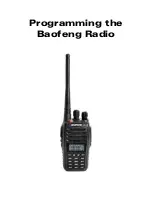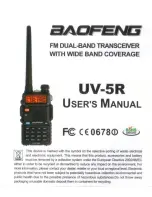
Applied Wireless Inc.
Remote Control Transmitters
Models KTXW303C6
Remote Control Receivers
Model RCR303C6R
Product Descriptions
These remote control receivers and transmitters are designed to provide a
quick and cost effective solution for a variety of wireless remote control
applications. The receiver includes six low voltage, internal, 10-Amp,
SPDT relays and an external whip antenna. Expected range with this
antenna is 450 to 600 feet*. The range may be increased substantially
through the use of an external dipole antenna (DP300A) at the receiver.
The receiver offers excellent sensitivity and selectivity by utilization of
SAW (Surface Acoustic Wave) technology and state of the art low noise
amplifiers.
The receiver runs on 12 to 24 Volts AC or DC (supply not included).
Through the use of DIP switch settings on the receiver board, the relays
can be individually configured for momentary, latched, or toggle modes.
The receiver can quickly “learn” up to four Applied Wireless transmitters
with different address codes. Alternatively, for applications requiring
many transmitters operating the same receiver, Applied Wireless can
provide transmitters with all the same address codes. Unless specified
otherwise, all transmitters come from the factory with a unique ID code.
A receiver will only respond to the transmitter whose ID code has been
“learned”. All other transmissions from transmitters with different ID
codes will be ignored.
Transmitters are watertight and available with 4, or 6 buttons. Power for
the handheld transmitter is supplied by two widely available coin cell
batteries (included). The six channel receiver will also work with Applied
Wireless’ KTX series keyfob transmitters, available in 1, 2 or 3 buttons.
* Unobstructed, straight line-of-sight range, when used with the standard antennas
included with the transmitter and receiver.
Installation Instructions
Before Beginning the Installation
Plan your installation carefully. The physical location and orientation of
the receiver will have a significant influence on reception, particularly at
longest ranges. For best results,
the receiver antenna, should be
positioned vertically on a non-metallic surface (pointing either up or
down).
If using an optional dipole antenna, it should also be oriented
vertically. If necessary, use double-sided foam tape or hook & loop
fasteners (not supplied) to secure the transmitter to a vertical surface.
Also, keep in mind that the RF signal from the transmitter will travel
through most non-metallic building materials (wood, stucco, brick, etc.),
however
maximum stated reception range is based on unobstructed line of
sight conditions.
Application Note: Factors Affecting Range Performance
The RF signal from the handheld transmitter will penetrate non-metallic
building surfaces, but is blocked (and reflected) by metal objects and
materials. As an example, signal reception through typical wood frame
and drywall construction is generally quite good, however the signal can
be significantly attenuated if the wall is covered with wire mesh and
stucco. Substituting an Applied Wireless Dipole Antenna, or Active
(amplified) Dipole Antenna (see Antenna Options table) for the receiver’s
standard whip antenna will significantly extend reception range. For
maximum range performance, the receiver’s antenna (whip or dipole)
should be oriented vertically, and placed as high above ground level as
possible.
Controlling 120V Circuits and High Amperage Loads
The RCR receiver is not UL listed, and 110 or higher voltage circuits
should not be directly connected to the receiver. These circuits can be
controlled however by using a contactor with a 24-VAC coil (AW PN
269006, 30A contactor). For low voltage loads over 10 Amps, Applied
Wireless offers high current relays (AWPN 269007, 30A 12VDC Relay)
that can be controlled by the RCR receiver.


























